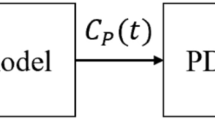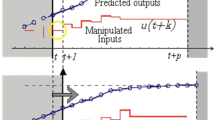Abstract
Inter-individual variability possesses a major challenge in the regulation of hypnosis in anesthesia. Understanding the variability towards anesthesia effect is expected to assist the design of controller for anesthesia regulation. However, such studies are still very scarce in the literature. This study aims to analyze the inter-individual variability in propofol pharmacokinetics/pharmacodynamics (PK/PD) model and proposed a suitable controller to tackle the variability. This study employed Sobol’ sensitivity analysis to identify significance parameters in propofol PK/PD model that affects the model output Bispectral Index (BIS). Parameters’ range is obtained from reported clinical data. Based on the finding, a multi-model generalized predictive controller was proposed to regulate propofol in tackling patient variability. \(Ce_{50}\) (concentration that produces 50% of the maximum effect) was found to have a highly-determining role on the uncertainty of BIS. In addition, the Hill coefficient, \(\gamma\), was found to be significant when there is a drastic input, especially during the induction phase. Both of these parameters only affect the process gain upon model linearization. Therefore, a predictive controller based on switching of model with different process gain is proposed. Simulation result shows that it is able to give a satisfactory performance across a wide population. Both the parameters \(Ce_{50}\) and \(\gamma\), which are unknown before anesthesia procedure, were found to be highly significant in contributing the uncertainty of BIS. Their range of variability must be considered during the design and evaluation of controller. A linear controller may be sufficient to tackle most of the variability since both \(Ce_{50}\) and \(\gamma\) would be translated into process gain upon linearization.










Similar content being viewed by others
References
Shafer S, Flood S, Schwinn DA. Basic principles of pharmacology. In: Miller RD, Eriksson L, Fleisher L, Kronish JW, Young WL, editors. Miller’s anesthesia, Chap 19. 7th ed. Philadelphia: Elsevier; 2010. p. 479.
Patel B, Patel H, Vachhrajani P, Shah D, Sarvaia A. Adaptive smith predictor controller for total intravenous anesthesia automation. Biomed Eng Lett. 2019;9:127–44.
Navarro-Guerrero G, Tang Y. Fractional-order closed-loop model reference adaptive control for anesthesia. Algorithms. 2018;11(7):106.
Naşcu I, Oberdieck R, Pistikopoulos EN. Explicit hybrid model predictive control strategies for intravenous anaesthesia. Comput Chem Eng. 2017;106:814–25. https://doi.org/10.1016/j.compchemeng.2017.01.033.
Krieger A, Pistikopoulos EN. Model predictive control of anesthesia under uncertainty. Comput Chem Eng. 2014;71:699–707. https://doi.org/10.1016/j.compchemeng.2014.07.025.
Soltesz K, Hahn JO, Hägglund T, Dumont GA, Ansermino JM. Individualized closed-loop control of propofol anesthesia: a preliminary study. Biomed Signal Process Control. 2013;8(6):500–8. https://doi.org/10.1016/j.bspc.2013.04.005.
Sawaguchi Y, Furutani E, Shirakami G, Araki M, Fukuda K. A model-predictive hypnosis control system under total intravenous anesthesia. IEEE Trans Biomed Eng. 2008;55(3):874–87.
Sartori V, Schumacher PM, Bouillon T, Luginbuehl M, Morari M. On-line estimation of propofol pharmacodynamic parameters. In: 2005 IEEE engineering in medicine and biology 27th annual conference, pp. 74–77 (2005)
Silva MM, Wigren T, Mendonça T. A reduced mimo wiener model for recursive identification of the depth of anesthesia. Int J Adapt Control Signal Process. 2014;28(12):1357–71. https://doi.org/10.1002/acs.2447.
Ting CH, Arnott RH, Linkens DA, Angel A, Mahfouf M. Generalised predictive control of evoked potentials for general anaesthesia. IEE Proc. 2002;149(6):481–93.
Westover MB, Kim SE, Ching S, Purdon PL, Brown EN. Robust control of burst suppression for medical coma. J Neural Eng. 2015;12(4):046004.
Hahn J, Dumont GA, Ansermino JM. A direct dynamic dose-response model of propofol for individualized anesthesia care. IEEE Trans Biomed Eng. 2012;59(2):571–8.
Derendorf H, Meibohm B. Modeling of pharmacokinetic/pharmacodynamic (PK/PD) relationships: concepts and perspectives. Pharm Res. 1999;16:176–85.
Saltelli A, Tarantola S, Campolongo F, Ratto M. Front matter. New York: Wiley; 2004.
Saltelli A, Annoni P, Azzini I, Campolongo F, Ratto M, Tarantola S. Variance based sensitivity analysis of model output. Design and estimator for the total sensitivity index. Comput Phys Commun. 2010;181:259–70.
Homma T, Saltelli A. Importance measures in global sensitivity analysis of nonlinear models. Reliab Eng Syst Saf. 1996;52(1):1–17. https://doi.org/10.1016/0951-8320(96)00002-6.
Martín-Mateos I, Méndez Pérez JA, Reboso JA, León A. Modelling propofol pharmacodynamics using bis-guided anaesthesia. Anaesthesia. 2013;68(11):1132–40. https://doi.org/10.1111/anae.12384.
Schnider TW, Minto CF, Gambus PL, Andresen C, Goodale DB, Shafer SL, Youngs EJ. The influence of method of administration and covariates on the pharmacokinetics of propofol in adult volunteers. Anesthesiology. 1998;88(5):1170–82.
Schnider TW, Minto CF, Shafer SL, Gambus PL, Andresen C, Goodale DB, Youngs EJ. The influence of age on propofol pharmacodynamics. Anesthesiology. 1999;90(6):1502–16.
Eleveld DJ, Proost JH, Cortinez LI, Absalom AR, Struys M. A general purpose pharmacokinetic model for propofol. Anesth Analg. 2014;118:1221–37.
Krieger A, Panoskaltsis N, Mantalaris A, Georgiadis MC, Pistikopoulos EN. Modeling and analysis of individualized pharmacokinetics and pharmacodynamics for volatile anesthesia. IEEE Trans Biomed Eng. 2014;61(1):25–34.
Kwok KE, Shah SL, Clanachan AS, Finegan BA. Evaluation of a long-range adaptive predictive controller for computerized drug delivery systems. IEEE Trans Biomed Eng. 1995;42(1):79–86.
Mahfouf M, Linkens DA, Asbury AJ, Gray WM, Peacock JE. Generalised predictive control (gpc) in the operating theatre. IEE Proc D. 1992;139(4):404–20.
Pawlowski A, Merigo L, Guzman JL, Visioli A, Dormido S. Event-based GPC for depth of hypnosis in anesthesia for efficient use of propofol. In: 2017 3rd international conference on event-based control, communication and signal processing (EBCCSP), pp. 1–7 (2017)
Clarke D, Mohtadi C, Tuffs P. Generalized predictive control—part I the basic algorithm. Automatica. 1987;23(2):137–48. https://doi.org/10.1016/0005-1098(87)90087-2.
Rossiter J. Model-based predictive control: a practical approach. Boca Raton: CRC Press; 2003.
Shafer SL, Gregg KM. Algorithms to rapidly achieve and maintain stable drug concentrations at the site of drug effect with a computer-controlled infusion pump. J Pharmacokinet Biopharm. 1992;20:147–69.
Struys MMRF, Smet TD, Greenwald S, Absalom AR, Bingé S, Mortier EP. Performance evaluation of two published closed-loop control systems using bispectral index monitoring a simulation study. Anesthesiology. 2004;100(3):640–7.
Author information
Authors and Affiliations
Corresponding author
Ethics declarations
Conflict of interest
The authors declare that there is no conflict of interest.
Rights and permissions
About this article
Cite this article
Jing, C.J., Syafiie, S. Multi-model generalised predictive control for intravenous anaesthesia under inter-individual variability. J Clin Monit Comput 35, 1037–1045 (2021). https://doi.org/10.1007/s10877-020-00581-0
Received:
Accepted:
Published:
Issue Date:
DOI: https://doi.org/10.1007/s10877-020-00581-0




